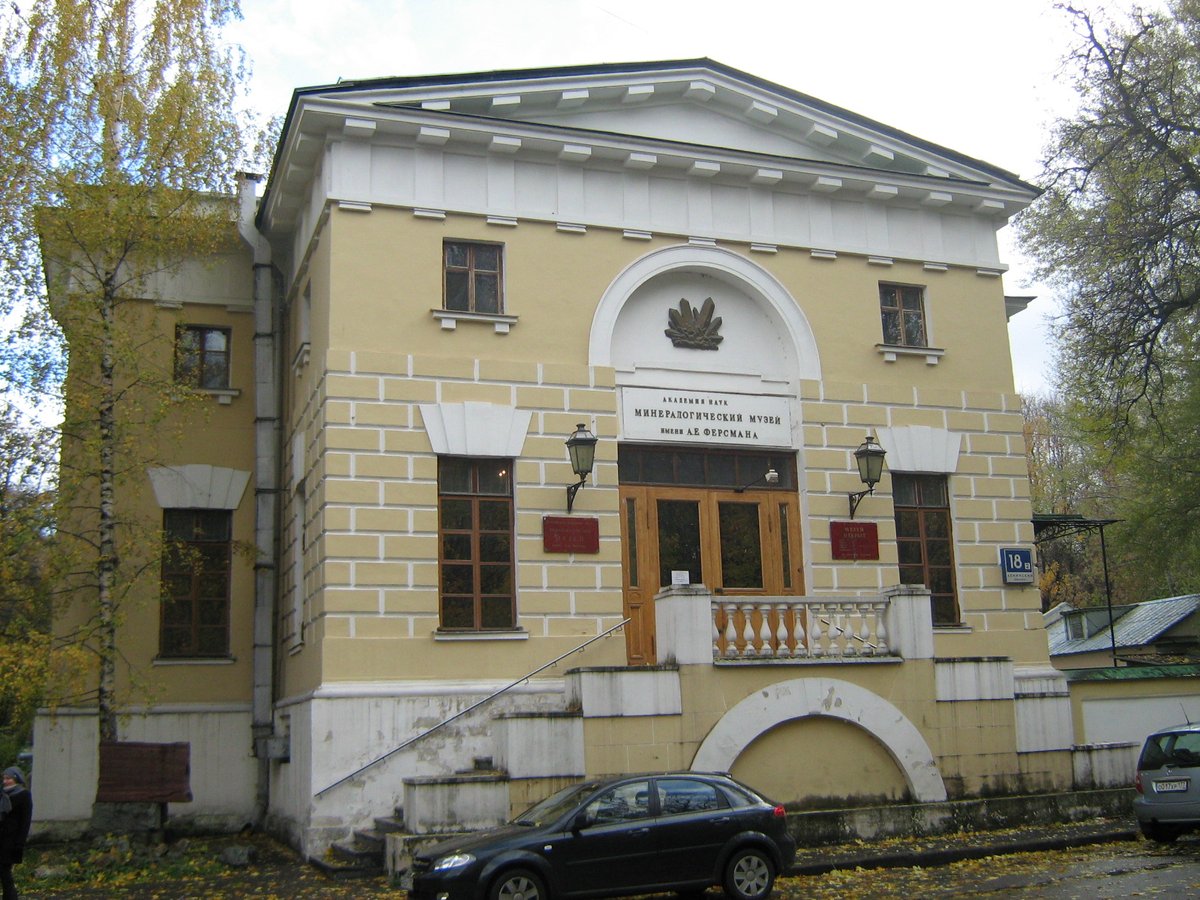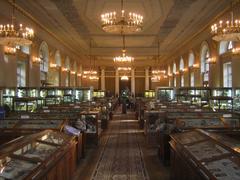
Fersman Mineralogical Museum Visiting Hours, Tickets, and Travel Guide | Moscow Historical Sites
Date: 14/06/2025
Introduction: The Fersman Mineralogical Museum’s Legacy
Located in the heart of Moscow, the Fersman Mineralogical Museum stands as a testament to Russia’s scientific heritage and cultural richness. Founded in 1716 as part of Peter the Great’s Kunstkamera, it has evolved into one of the world’s oldest and most extensive mineralogical museums. Home to over 135,000 specimens—including roughly half of all known mineral species—the museum also showcases fascinating meteorites and masterful Fabergé artworks, making it an essential destination for mineral enthusiasts, history lovers, and anyone seeking to explore Moscow’s historical sites (Fersman Mineralogical Museum Visiting Hours, Tickets & History; Fersman Mineralogical Museum in Moscow: Visitor Guide, History, and Highlights; Fersman Mineralogical Museum Visiting Hours, Tickets & Exhibitions in Moscow).
The museum’s collections trace the development of mineralogy in Russia, from the acquisition of the famed Pallas Iron meteorite in 1772 to modern scientific advancements under leaders like Vladimir Vernadsky and Alexander Fersman. Systematic exhibits, interactive displays, bilingual labels, and accessible facilities ensure an engaging experience for all visitors. Its location near prominent metro stations and other cultural landmarks further enhances its appeal as a cornerstone among Moscow’s historical attractions (Fersman Mineralogical Museum Visiting Hours, Tickets & Visitor Guide in Moscow).
Contents
- Historical Overview
- Visitor Information: Planning Your Visit
- Museum Collections and Exhibitions
- Travel Tips and Nearby Attractions
- Frequently Asked Questions (FAQ)
- Summary and Recommendations
- Sources and Official Links
Historical Overview
Origins and Early Development
Founded in 1716 within the Kunstkamera, the Fersman Mineralogical Museum’s mineralogical collections were initially established to advance Russia’s scientific research and education. By the early 20th century, under the guidance of Vladimir Vernadsky, the museum’s holdings were organized into five main collections: Systematic, Crystal, Locality, Pseudomorph, and Gems and Stone Art (Fersman Museum Collections).
Growth and Scientific Milestones
Through the 19th and 20th centuries, the museum expanded via scientific expeditions, donations, and international acquisitions. Its systematic collection now contains over 90,000 specimens, representing around 2,400 mineral species—more than half the world’s known total. The crystal collection, with 4,800 specimens, and locality collections documenting over 300 mineral deposits, highlight Russia’s mineralogical diversity.
The Meteorite Collection
A notable legacy is the museum’s meteorite collection, beginning with the Pallas Iron meteorite in 1772. Today, it is Russia’s largest, featuring 45 registered meteorites and rare mineral species found in meteorites, tektites, and impactites (Fersman Museum Meteorite Collection).
Soviet Era and Modernization
During the Soviet period, the museum became a national research hub. Significant collections—such as pseudomorph specimens and Fabergé-designed gemstone art—were added, blending scientific and artistic value (Fersman Museum Collections).
Public Engagement and Institutional Role
As part of the Russian Academy of Sciences, the museum prioritizes accessibility, education, and research. Permanent and temporary exhibitions, guided tours, and outreach programs ensure the museum remains a vibrant center for visitors and scholars alike.
Visitor Information: Planning Your Visit
Location and Transport
Address: Leninsky Prospekt 18, Moscow, Russia, 119334
Metro: The nearest stations are Universitet, Leninsky Prospekt, and Oktyabrskaya. Buses and electric buses (except e10 and e12) stop at “Больница Святителя Алексия” (St. Alexius Hospital).
Opening Hours
- Wednesday–Sunday: 11:00 a.m. – 5:00 p.m.
- Closed: Mondays and Tuesdays
Tickets
- Standard Entry: Purchase at the entrance or online (official website)
- Free Admission: First and last Wednesday of each month
- Adults: 300–500 RUB
- Students/Seniors: 150–300 RUB
- Children under 16: Free
- Guided Tours: Available in Russian daily; English tours by advance request (additional fee)
Accessibility
- Wheelchair accessible (ramps and elevators)
- Restrooms and cloakroom available
- Some areas in the historic building may have limited accessibility—contact the museum in advance for special needs
Visitor Amenities
- Souvenir kiosk with mineral samples, books, and gifts
- No on-site café, but dining options are available nearby
Museum Collections and Exhibitions
Permanent Exhibitions
- Systematic Mineralogy: Minerals grouped by chemical class, with bilingual labels
- Gemstones and Fabergé Art: Rough stones, faceted gems, and about 30 Fabergé masterpieces
- Meteorite Gallery: Russia’s largest meteorite collection, including the Pallas Iron and Chelyabinsk fragments
- Russian Mineral Heritage: Specimens from the Kola Peninsula, Urals, Siberia, and the Caucasus
- Crystallography Hall: Large crystals and models illustrating crystal structures
Notable Collections
- Stepanov Collection: Over 15,000 unique mineral specimens
- Godovikov Collection: Rare minerals from depleted Russian sites
- Artistic Stonework: Lapidary art, carved vases, and figurines
Temporary Exhibitions and Educational Programs
- Regularly changing exhibitions on new mineral discoveries and stone art
- Educational workshops and lectures for students and families
- Interactive digital catalogs and touchscreen displays
Photographic Opportunities
- Photography permitted (no flash or tripods)
- Recommended photo spots: Fabergé showcases, meteorite displays, and crystal exhibits
Travel Tips and Nearby Attractions
- Best Time to Visit: Weekdays, especially Wednesdays for free entry
- Nearby Sites: Neskuchny Garden, Donskoy Monastery, and the Lenin Library
- Duration: Plan for 1.5–2 hours to fully explore the museum
- Language: Most labels are in Russian; some have English—consider a tour or translation app
- Souvenirs: Unique mineral samples and educational gifts available at the museum shop
For accommodation, options range from luxury hotels (Four Seasons, Ritz-Carlton) to budget hostels nearby (Hotels near Fersman Museum).
Frequently Asked Questions (FAQ)
Q: What are the museum’s opening hours?
A: Wednesday–Sunday, 11:00 a.m. – 5:00 p.m.; closed Mondays and Tuesdays.
Q: Are guided tours available in English?
A: Yes, with advance booking.
Q: Is the museum accessible for people with disabilities?
A: Yes, but some historic areas may be limited—contact ahead for assistance.
Q: Can I take photos inside?
A: Photography is allowed without flash or tripods.
Q: How do I buy tickets?
A: At the entrance or online via the official website.
Contact and Stay Connected
- Website: www.fmm.ru
- General Info: +7(495)954-39-00
- Tours: +7(916)629-80-52
- Email: [email protected]
- Telegram: Fersman Museum Telegram
- YouTube: Fersman Museum YouTube
Follow the museum on social media for updates on exhibitions and events.
For exclusive audio guides and interactive tours, download the Audiala app.
Summary and Visitor Recommendations
The Fersman Mineralogical Museum is a premier destination for exploring Earth’s mineral diversity and Russia’s scientific and artistic achievements. Its vast collections, educational programs, and accessible facilities make it ideal for families, students, researchers, and tourists. Plan your visit with ease—comprehensive information on hours, tickets, and transport ensures a smooth experience. Enhance your journey with digital resources and stay engaged through the museum’s active online presence. For anyone interested in mineralogy, Russian culture, or the history of science, a visit to the Fersman Mineralogical Museum is an unmissable highlight of Moscow (Fersman Mineralogical Museum Visiting Hours, Tickets & History; Fersman Mineralogical Museum Visiting Hours, Tickets & Exhibitions in Moscow; Fersman Mineralogical Museum Visiting Hours, Tickets & Visitor Guide in Moscow).
Sources and Official Links
- Fersman Mineralogical Museum Visiting Hours, Tickets & History: Your Ultimate Guide to Moscow’s Premier Mineralogical Institution, 2025
- Fersman Mineralogical Museum in Moscow: Visitor Guide, History, and Highlights, 2025
- Fersman Mineralogical Museum Visiting Hours, Tickets & Exhibitions in Moscow, 2025
- Fersman Mineralogical Museum Visiting Hours, Tickets & Visitor Guide in Moscow, 2025





















































































































































































































































































